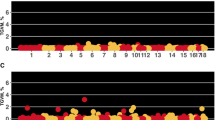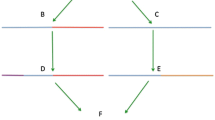Abstract
Reproductive traits have low heritabilities, are expressed in only one sex, and are not measurable until sexual maturity (Avalos and Smith, Anim Prod 44:153, 1987). Using traditional methods, selection for reproductive traits is relatively less effective than selecting for growth or carcass traits. Traits most affected by a small number of genes with major effects rather than many genes with small effects are most amenable to MAS. As part of our porcine genome scan to identify quantitative trait loci (QTLs) of economic importance in marker-assisted selective (MAS) breeding programs, we examined 8 reproductive and farrowing traits in the University of Illinois (UI) Meishan × Yorkshire Resource Family. Gilts were genotyped with 119 microsatellite markers (MS) with intervals averaging 24 cM over all 18 porcine autosomes. F-ratios supporting QTL location were calculated by the least squares regression method. Results suggestive of linkage at the 5% genome-wide level were observed for the number of stillborn piglets on Chromosome (Chr) 4 (SSC4) (p-value = 0.0001), corpora lutea on SSC8 (p-value = 0.00027), and gestation length on SSC9 (p-value = 0.00019). Results for additional loci relevant to litter size, number of corpora lutea on SSC15 and 7 (p-value = 0.0029 and 0.0028 at 107 and 150 cM, respectively), gestation length on SSC15 and 1 (p-value = 0.0017 and 0.0069 at 96 and 166 cM, respectively), uterine length on SSC7 and 5 (p-value = 0.0044 and 0.0075 at 148 and 1 cM, respectively) and piglets born per litter on SSC6 (p-value = 0.0075 at 102 cM), were not statistically significant at the 5% genome-wide level. Thus, the use of a linked marker to facilitate selection for reproductive traits has considerable potential. By using linked markers, selection can be applied to both sexes before sexual maturity, making genetic selection considerably more efficient and less costly.
Similar content being viewed by others
Author information
Authors and Affiliations
Additional information
Received: 24 June 1998 / Accepted 29 January 1999
Rights and permissions
About this article
Cite this article
Wilkie, P., Paszek, A., Beattie, C. et al. A genomic scan of porcine reproductive traits reveals possible quantitative trait loci (QTLs) for number of corpora lutea. Mammalian Genome 10, 573–578 (1999). https://doi.org/10.1007/s003359901047
Published:
Issue Date:
DOI: https://doi.org/10.1007/s003359901047




